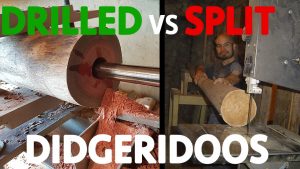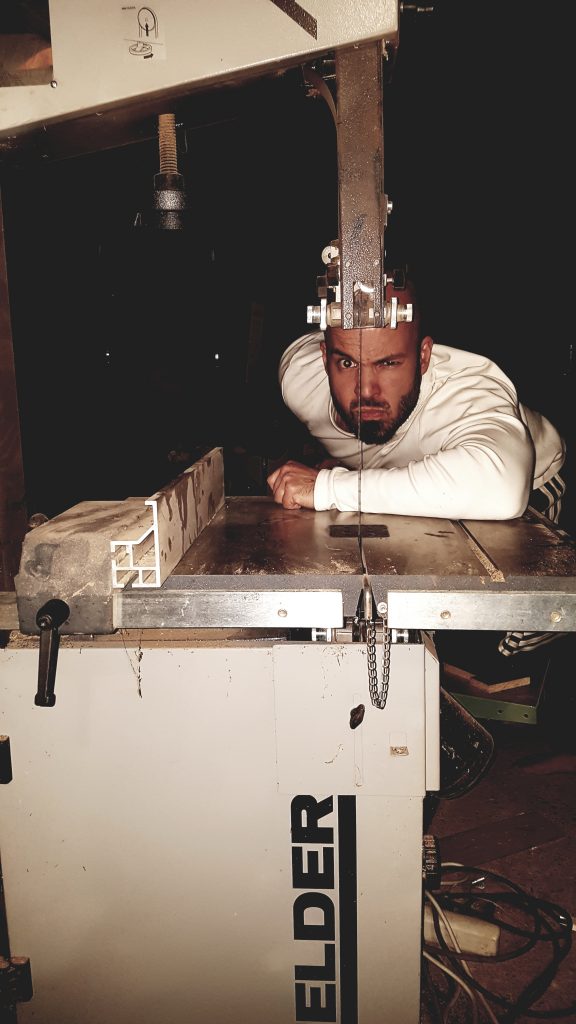Drilling didgeridoos is one aspect of didgeridoo world which has both mystical and mythical properties. It is mystical as almost no one knows how to do it, how to do it well, how to do it with challenging wood (like eucalyptus traditionally eaten by termites), how drilling rig works etc. The mythical properties come for the same reason. It is just not easy to drill something which is 2 meters long, and sometimes bent a bit.
So my didgeridoo making journey started almost 20 years ago, and my drilling didgeridoos started a bit more than 10 years ago. It took us one whole year to get a good understanding of what is going on there. Many mistakes. Many frustrating mistakes. You can think of a scenario where your drill goes out of the wood 30 cm before the end, or when your drill or chisel gets stuck somewhere in the middle.
In this video I outline and explain my point of view to the drilling vs split & hollow process, on a nice morning walk through my “backyard”.
However I will list all the pro and con at one place so that you can have it as a reference in the moments of doubt of how you want to continue your didgeridoo making journey.
Split and Hollow Pro
- short learning curve of the process – not short for making great didges, but short for making basic didgeridoos compared to drilling
- cheaper “pro” tools, you can go by with a few hundred euros, especially if you outsource bandsaw cutting
- cannot easily make a mistake which ruins the whole didgeridoo
- wood can be very bent and the selection is wider
- it is much easier to make a complex shape that has an opening and then closing again
- gets just linearly more difficult with long and hard wood
Split and Hollow Con
- you always have a joint
- it is difficult to have exact repetition of a shape (here I don’t take into account CNC hollowing)
- you have to know well and in advance what you want as there is much less what you can do later due to wood thickness and sometimes non straight wood
- you only try one didge when you make it or just small variations by making it a bit shorter or longer
- price of a good bandsaw
- the process is usually a backbreaker
- usually uglier inside than a drilled didge
Drilling and Chiseling Pro
- you can try many didgeridoos along the way of making one and you can learn tremendously about didgeridoos
- you can iterate your didgeridoo towards the desired result, you don’t have to know exactly how to get what you want in the beginning
- you have great repeatability of the instruments
- you have great precision in choosing a part which is say 35mm diameter circle- you can do it with absolute precision, even more than with CNC ( I say this because with CNC you still have to make a joint in wood)
- you see the totality of didgeridoo and you can learn to feel the “volumes” and you can learn how each affects the other
- no joint
- usually more beautiful inside than a sandwich didge
Drilling and Chiseling Con
- long learning curve with usually quite frustrating mistakes
- “pro” equipment is expensive and you have to make many of it, so it is very time and money consuming
- mistakes are often fatal for the didge
- usually slower than split and hollow
- gets exponentially more difficult for long and hard wood
- the process of chiseling and process of thinning wood are difficult as well, especially with long and hard wood
For my personal priorities I chose drilling for the reason of precision, learning and iteration towards perfection. But I understand that many players don’t have those priorities and that they will choose split and hollow (or fiberglass or…) technique and it is all fine. But due to the comments I get I want to make clear that the choice of drilling is NOT a choice because you have MONEY. The main thing that you need to invest is huge amount of ENERGY to get the skill and know-how of drilling and the rest of that process.
If you want to start a bit with drilling, you can know that you can start with very basic tools. Even hand drills can work very well. Keep in mind to make simple instruments in the beginning. A simple instrument can be a cylindric didge of pine, 130cm long. I also want to offer you a small list which I find to be useful.
Legendary drilling video with ultracool Grandpa https://www.youtube.com/watch?
A drill that my wood would turn into drill dust, but maybe with soft wood it works… https://www.instructables.com/
I hope you enjoyed this small tour.
Spiral Out!
– Du


tristan omeara December 29, 2018, 02:24
gday mate 😉 mr tristan here from australia, long time no see dude, was interesting little vid an ddiscussion, i too have tried many yrs ago the drilling of hardwoods (euc logs.) very difficult! had some success but not consistant enough. myself i will always make termite hollowed didge as this is my market and what i love 🙂 but i find it interesting to make some euc drille dlogs too, thought you may be interested to trade some solid euc logs of nice shapes and features on the bell and good lengths? im very well set up for harvesting good logs, but im interested to learn some techniques for drilling them successfully! there is some guys in nth qld ive seen drill out some very small termite hollowed logs and open them up more to 35mm with drilling by following the very small termite holes, but ive not tried this, only tried to drill completely solid. as you say it has many problems and is expensive to set up. anyways if you wanna chat about anything regarding some supply of logs bro and soem ideas on successful drilling, id be interested to talk more. i believe there is still a good market to grow in high quality australian euc didjis made from drilled logs. many people still will want termite logs im sure and i love the magical discoverys of these types of logs, however i am ver yinterested in th precision and perfection of playing qualitys and this can come very nicely from drilled and chiseled logs i believe. hope life is good to you whereever you are mate. safe travels and kind regards, tristan omeara
Du March 18, 2019, 17:24
Tristan!! So nice to hear from you! Sorry that it took me ages to reply. It just sometimes happens. I think that for you it makes a lot of sense to make termite eaten didges since you are at a source of the logs and in my not humble opinion at all, you are now a top termite eaten didgeridoo maker. I haven’t been trying many termite euc didges lately, but I have tried yours and they are simply great! Also very beautiful. With knowing as much as I know about drilling I would talk you away from it. Simply because it is so f-ing hard to do well, especially with long and hard wood. This doesn’t mean I am not interested in logs, but at the moment I am so overwhelmed with all things didgeridoo that I can’t fit even one bit more. But it is good to know that I can count on you!!! Huge hug and loads of luck on your travels!
Du
Eric Engert March 13, 2023, 04:20
Why is there this focus on and seemingly the requirement to have a smooth inside, did the termites know to do this with the trees they hollowed? did aboriginals clean out the whole tube of the didgeridoo or yidaki and if so what did they use? I have made a number of split didges and not focused on smoothing the inside and I also have aquired a number of termite hollowed logs and they all sound good. If your boring it with a lathe or other large drill it is obviously no longer authentic.
Marcus May 12, 2023, 14:38
Hi, I’m quite young in didge building, started in 2020. From the beginning my goal was drilling them. I got hand drills from Slovakia.
After making the first obvious mistakes (you mentioned them above), I came up with a few quite good didges.
But:
I figured out that without chiselling I won’t be able to go further on that path.
I would like to ask you for advise what shapes of chisels I need and where I can get them.
The idea of chiselling in the dark makes me really enthusiastic.
So, if you’re willing to share some knowledge I’d be grateful.
Lep pozdrav iz Tolmina v Sloveniji.
Marcus